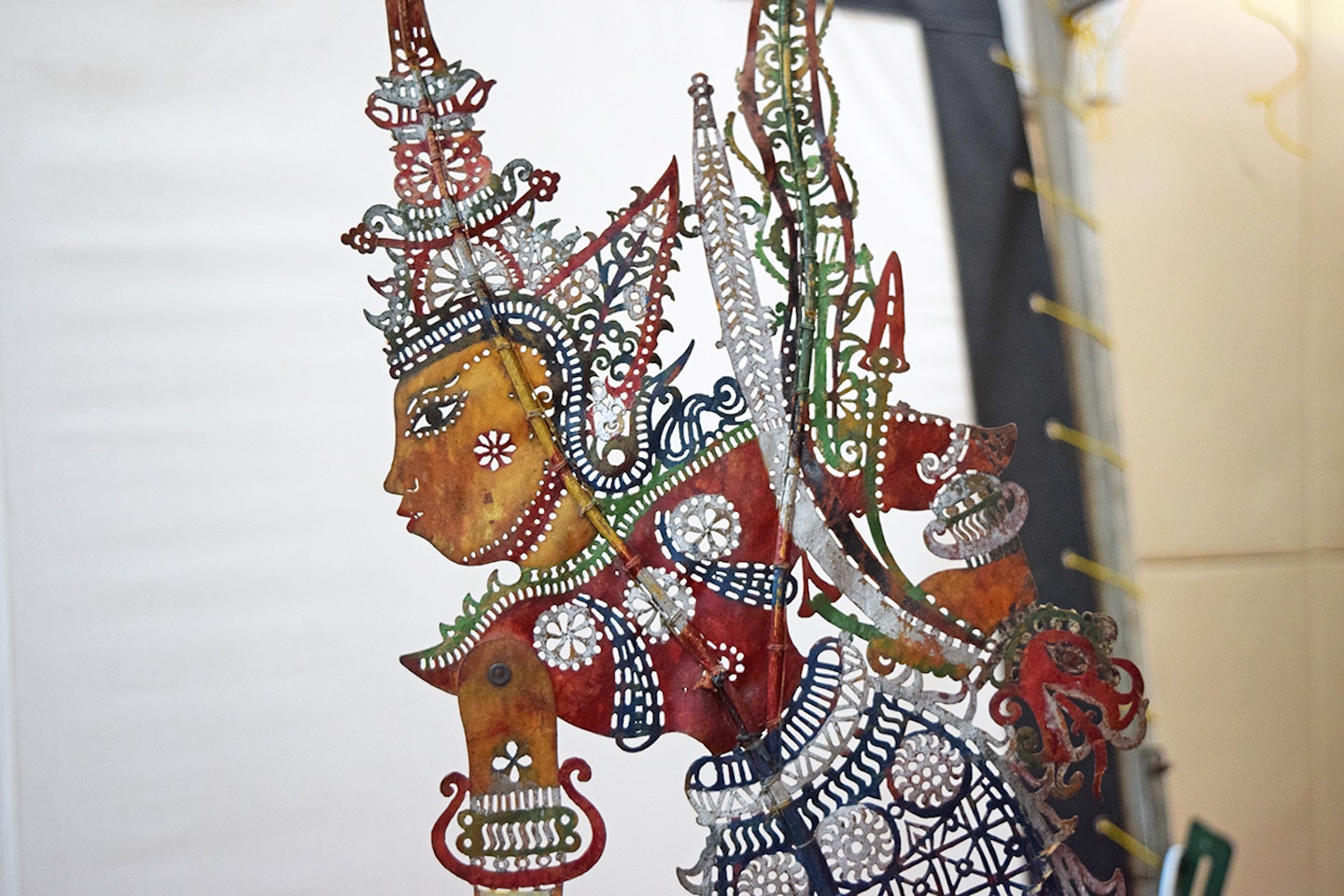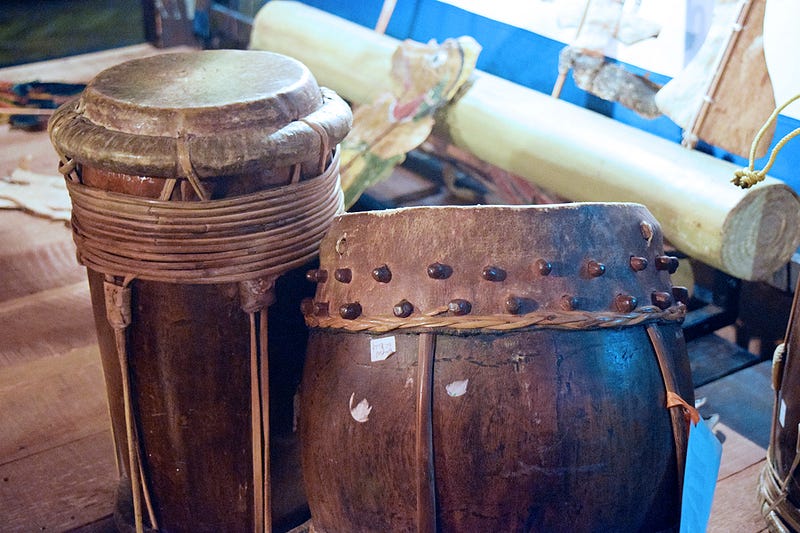September 02, 2016
Mohd Jufry: Protector of leather shadow puppets in Malaysia

“You know, there’s a difference between Malaysian shadow puppets and the ones in Thailand and Indonesia. Character design, for example. We want people to know that difference — that this is Malaysian wayang kulit art.”
There was construction going on at the art museum of University of Science in Malaysia, that day. Jufry’s wife suggested that we go upstairs to find a quieter place to talk. She and her daughter were present that day to support Jufry. We sat at a lounge area near an exhibition on planets. As Jufry spoke, his wife and daughter would often interject to amplify his points. They want to help him with accomplishing his dream of bringing the art of shadow puppets to an international level and for the world to know what exactly wayang kulit is. Through, VAWAA he plans to share the art with the world.

Mohd Jufry in his studio in Penang, Malaysia. Courtesy of Geetika Agrawal.
Jufry came from a lineage of wayang kulit dalangs or commonly known as puppeteers. Growing up in his grandfather’s house, he had an everyday exposure to this art. His grandfather would hold performances as well as teach people the art of wayang kulit. “We would play by ourselves without the music — just following like how the adults did,” he recalled of his childhood days playing with characters out of paper.
As a young adult, he realized that wayang kulit was something he needed. With the knowledge he has gathered since childhood, he follows in the footsteps of his grandfather but with bigger ambitions. “I feel the need to protect and uphold the art. It’s time for wayang kulit to be brought to greater heights,” he shares with us.
Going in full on teacher mode and connoisseur of the art, he strived to educate us on the art and give insight to the craft:
This interview was originally conducted in Malay.
Besides music and characters, what other aspects are there to a wayang kulit show?
We need one more thing: perdalangan. Puppeteers! They are the most important for the show because they run it. It’s not easy to be a puppeteer, though. There’s rules and guidelines to be followed. They need to know differences of intonation and be able to make various sounds and voices. If it’s a female character they’re playing — they need to know how to make a woman’s voice. And they have to be able to make a quick switch to perhaps a monster’s voice.
“It’s also about talent: there’s a lot of voices to be made because there’s a lot of characters,” Jufry’s daughter added.
How many characters are there normally?
It really depends on the story line but a minimum of 10–12 characters.
Wow! That’s a lot of voices. How does someone learn wayang kulit?
There’s a difference between the way to learn in the past and now. In the past, whenever there was a performance, we would go. Whatever the teacher did, we would follow. Now, people go to class and look at the score. But, it’s nothing really. The best way to learn is by observation. Observe what is happening and always stick to the story.
What’s the story?
The epic of Ramayana. There’s normally a protagonist and an antagonist.

Sri Rama and Sri Dewi — Wayang kulit characters carved out of cured goatskin. Courtesy of Geetika Agrawal.
A good guy and bad guy, basically?
Yes, Rawana is the bad guy. Sri Rama is our hero — the good guy. There’s Sri Dewi, who’s the queen. They normally fight over her. So, the stories really revolve around love and war.
We followed Jufry and family to his studio and he showed us his characters. Rawana (the baddie), had stubby features and was perpetually more ugly-looking. Sri Rama, on the other hand, had finer and more detailed features.
How long does it take you to complete these characters?
A week to do the carvings for Sri Rama because that requires more precision and you have to be careful with the fine lines. While for characters like Rawana, with no distinct features, it takes 2 days to get ready. But, for the performances I don’t normally make new puppets.
What do you mean by that?
The puppets we use have already been around for a long time — 70 to 80 years old, since the time of my grandfather. Characters are made when they are spoilt or if there’s a new story line. There are about 150 different characters and they’ll follow the story that they’re in.
How are the characters structured in the show?
The hero comes from the right and the bad guy from the left. The pohon beringin (accompanying branch) is the piece that starts the show. We also use it as an interval — when a human is turning into a monster or as fire. We also use it as a house, too!
The pohon beringin looked like a leaf but if you look even closer — you will find exquisite details of a tree with animals surrounding it. “It’s a symbol of life,” Jufry explains. How fitting that it begins the show with it.
Wayang Kulit is very much about tradition, isn’t it?
I follow whatever my grandfather has passed down to us. We don’t add to it or subtract anything from it. We play it exactly like how he would. For me, I want to keep the tradition.
Can anyone be a puppeteer?
In Kelantan, in order to be a dalang, it has to be something inherited. It’s based on your bloodline. I got it from my grandfather as his grandchild. It was easy because I grew up with it and was used to it. Nowadays, there are puppeteers but their education in the art is incomplete. When I talk about it, I’m speaking from a dalang perspective because that is my origin. So, I will hold on to it, pass it on to my children and hopefully the world too!

Musical instruments used during the show. Courtesy of Geetika Agrawal.
What does a puppeteer have to specifically know in order to be one?
The Tok Dalang has to know theoretically everything: sound intonations, how to move his hand, the standard speeches, when to cue in the music, how to sing…
He sings too?
Yes, he does that while talking! Depending on the story, there will be 2–3 songs on average. If the tok dalang can’t sing, there won’t be any songs, then.
How does this traditional art remain relevant to a modern time?
Speaking from my heart, the ways of modernity needs to go on but it cannot spoil the tradition. That’s something I’m really against. If they want to make the music faster and modern, it can be accepted. But, in terms of the story, because they are taking the concept of screen and shadow — that’s a thin line to thread on. We have done it too but it’s just something on the side. What I focus on is the origin. I can accept these changes but I won’t play it.
Could you give me an example of modern changes?
Okay, let’s compare Thailand and Malaysia. In Thailand, for music they use a keyboard, violin, and drums. These are modern instruments. In Malaysia, we change in terms of the story. We maintain the music with traditional instruments. My friend recently did a wayang kulit show based on Star Wars. The story was Star Wars but the music was traditional. That is still accepted.
What other differences are there to shadow puppets in Thailand and Malaysia?
Music, puppet design and the language. In Malaysia, we stick to Kelantanese wayang kulit while in Thailand they have changed it and not kept to their culture. The spirit of Kelantanese is almost fanatical to not change. You could say we’re fanatics…
Like you’re loyal?
Yes, loyalty!
In Malaysia itself, how many types of wayang kulit are there?
We have 4 different types of wayang kulit in Malaysia. From Kelantan, we have wayang Kelatan and wayang Melayu. From Kedah, we have wayang Gedik. And lastly from Johor, we have wayang Johor. Wayang Melayu’s characters are similar to the one in Johor but instruments and story are different. Kedah’s wayang Gedik has stories similar to Thailand. While wayang Johor is similar to Indonesia. But, the most famous of these all are — wayang Gedik and wayang Kelantan.
For you, what’s the most satisfying thing about wayang kulit?
It’s the moment of my grandfather’s time when he sang. When I hear it, I remember him. Now, when I sing, I’m brought back to those fond memories. Even though I don’t have a sound recording of his voice, there are other descendants with the same teacher as his teacher — and I have recordings of that. I also use that as a sort of guide. And, when I feel down, I listen to it too!

Mohd Jufry in his studio. Courtesy of Geetika Agrawal.
The art of wayang kulit or shadow puppet play is an inheritance and treasure like no other to Jufry. It is not just about wanting to do the art but it’s a necessity to his life. His passion for it is like a burning flame that cannot be dulled and as energetic as a wayang kulit show, itself! It’s not enough for him to pass down the tradition to his children but it’s time he passed it down to the world.
Written By Ann Ravinther
Vacation With Mohd Jufry in Penang, Malaysia
For more stories and new artist updates, subscribe here.